Celebrating over Three Decades of Voyaging, Since 1975
What Makes Hokule'a Special, Valuable and Unique?
Views from the Crew

(See Never Lost: Polynesian Navigation [a website by the Exploratorium in San Francisco], for video interviews with Hōkūle‘a crew members, including founders Ben Finney and Herb Kawainui Kāne; pwo navigators Chad Kālepa Baybayan, Milton “Shorty” Bertelmann, Bruce Blankenfeld, Chadd ‘Onohi Paishon, and Charles Nainoa Thompson; and president of the Friends of Hōkūle‘a and Hawai‘iloa Billy Richards.)
1974 Becoming a Crew Member of Hokule’a, Nainoa Thompson / Full Text
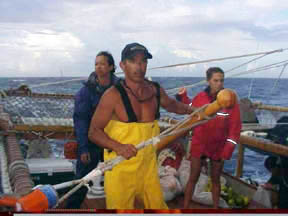 It was the first year I was paddling for the Hui Nalu Canoe Club, and I happened to be in the right place at the right time. Herb Kane was living across the canal from the club at Maunalua Bay. It was 1974, and Herb, Tommy Holmes, and Ben Finney were designing Hokule'a. The canoe hadn't been built yet, but they had a smaller canoe then, and they'd ask us to paddle it out of the canal over the reef into the open ocean. That was great! I was at the club every day so I could take the canoe out. Then one day, Herb invited two of the paddling coaches and me over to his house. Herb's house was filled with paintings and pictures of canoes, nautical charts, star charts, and books everywhere! Over dinner Herb told us how he, Ben and Tommy were going to build a canoe and sail it 2,500 miles without instruments-the old way. "We're going to follow the stars, and the canoe is going to be named after that star," Herb said, pointing to Hokule'a. This voyage would help to show that the Polynesians came here to Hawai'i by sailing and navigating their canoes-not just drifting by accident here on ocean currents or driven off course by storms. The voyage would demonstrate something very important for the Hawaiian people and for the rest of the world. In that moment, all the parts of my life that had seemed disconnected came together in me. I was 20 and looking for something challenging and meaningful to do with my life. I had a hard time finding that inside the four walls of a classroom. But now here it was-the history, the heritage, the charts, the stars, the ocean, and the dream ... there was so much relevance in that dream. I wanted to follow Herb; I wanted to be a part of that dream.
It was the first year I was paddling for the Hui Nalu Canoe Club, and I happened to be in the right place at the right time. Herb Kane was living across the canal from the club at Maunalua Bay. It was 1974, and Herb, Tommy Holmes, and Ben Finney were designing Hokule'a. The canoe hadn't been built yet, but they had a smaller canoe then, and they'd ask us to paddle it out of the canal over the reef into the open ocean. That was great! I was at the club every day so I could take the canoe out. Then one day, Herb invited two of the paddling coaches and me over to his house. Herb's house was filled with paintings and pictures of canoes, nautical charts, star charts, and books everywhere! Over dinner Herb told us how he, Ben and Tommy were going to build a canoe and sail it 2,500 miles without instruments-the old way. "We're going to follow the stars, and the canoe is going to be named after that star," Herb said, pointing to Hokule'a. This voyage would help to show that the Polynesians came here to Hawai'i by sailing and navigating their canoes-not just drifting by accident here on ocean currents or driven off course by storms. The voyage would demonstrate something very important for the Hawaiian people and for the rest of the world. In that moment, all the parts of my life that had seemed disconnected came together in me. I was 20 and looking for something challenging and meaningful to do with my life. I had a hard time finding that inside the four walls of a classroom. But now here it was-the history, the heritage, the charts, the stars, the ocean, and the dream ... there was so much relevance in that dream. I wanted to follow Herb; I wanted to be a part of that dream.
1976 Landfall Tahiti, Nainoa Thompson (Nainoa was not a crew member on the first voyage to Tahiti; he was assigned to serve as a crew member on the voyage home. He flew to Pape'ete, Tahiti, to join the crew and was there to witness the exuberant welcome that Hokule'a received when she arrived.)
In 1976, Hokule'a sailed on its historic voyage to Tahiti. Kawika Kapahulehua skippered the canoe, and Mau Piailug was the navigator. Never before had Mau been on such a long journey, never before had he been south of the equator where he could not see the North Star, a key guide for his travels. Nevertheless, sensing his way over 2,500 miles, using clues from the ocean world and the heavens, clues often unnoticed to the untrained eye, he found, after 30 days of sailing, the island of Mataiva, an atoll in the Tuamotu island group. At the arrival into Pape'ete Harbor, over half the island was there, more than 17,000 people. The canoe came in and touched the beach. There was an immediate response of excitement by everybody, including the children. So many children got onto the canoe they sank the stern. We were politely trying to get them off the rigging and everywhere else, just for the safety of the canoe. None of us were prepared for that kind of cultural response--something very important was happening. These people have long traditions and genealogies of great navigators and canoes. What they didn't have was a canoe. And when Hokule'a arrived at the beach, there was a spontaneous renewal, both an affirmation of our great heritage, and also a renewal of the spirit of who we are as a people today.
1980 Landfall Hawai’i, Nainoa Thompson / Full Text
I stand on the bow of Hokule'a watching the sun dropping toward that cloud bank and I question how much control, if any, I have in finding the land. This is the way things are supposed to be. Closer and closer it comes to the cloud, and I have a different, almost strange feeling. The sun is right in the compass direction of 'Aina-land. It is pointing out the land. I walk to the bow of the canoe for I know the island is there. I don't know how I know. Steve Somsen also knows. Not that he really knows, but he's picked up on my knowing it's there. Suddenly a particular cloud begins separating. It has the same quality as other clouds in terms of whiteness. But this one is not traveling. It's stationary, and it opens up to reveal a long, gentle slope with a slight bump–a cinder cone on the side of Mauna Kea! The navigation at this moment seems to be out of my hands and beyond my control. I'm the one given the opportunity of feeling the emotion of the navigator not yet ready to have a complete understanding of what is happening. It is a moment of self-perspective, of one person in a vast ocean given an opportunity of looking through a window into my heritage. I hear the crew cheering as the edge of the sun begins disappearing behind Mauna Kea. I feel their happiness, but a silence in me sets in. Venus follows the sun and touches the mountain an hour later. It is now time to sleep, for there is nothing else to do. The sun has led us to the land. Ahead of us is our ku'ula, and I'm filled with a feeling of emptiness and gratitude. [I remember a story I was told one time (how accurate I do not know) of the people of ancient Polynesia. They had their family guardians, ku'ula, that gave them prosperity. They were symbolized as figures shaped of carved stone. Fishing families had their ku'ula that attracted fish and gave them protection. The navigator of old, as the story goes, was not like other men. He was separated from them-a man of the sea, not of the land. So his ku'ula was not bound to the land but was the land itself-the highest mountain, a mountain of power.]
1985 Greeting in Aotearoa, Nainoa Thompson / Full Text
After we landed, we were invited to a very special occasion at the marae at Waitangi. We were greeted in the traditional way. We learned that the marae houses wellness for the Maori people. We watched grandchildren and grandparents dance together and sing together. We understood that these marae housed not just people, but the genealogies by which they traced their ancestry back to the canoes that brought them to Aotearoa. I can see how connected the Maori are to their ancestry. And because they are connected to their past, I believe that it's much easier for them to see the kind of future they want to voyage to. This was another part of our own work toward renewal. Sir James Henare, the most revered of the elders of Tai Tokerau, got up and said, "You've proven that it could be done. And you've also proven that our ancestors did it." On this very special occasion, he laughed and he cried. I recognized from him that we already come from a powerful heritage and ancestry. The canoe, on its voyages, is just one instrument to connect to that. Sir James Henare also made an incredible statement: "... because the five tribes of Tai Tokerau trace their ancestry from the names of the canoes they arrived in, and because you people from Hawai'i came by canoe, therefore by our traditions, you must be the sixth tribe of Tai Tokerau." We didn't know what to make of such a powerful statement. In a few sentences, Sir James Henare had connected us to his people. And he said that all the descendants from those who sailed the canoe are family in Tai Tokerau.
1986 Landfall Tongatapu, Carlos Andrade / Full Text
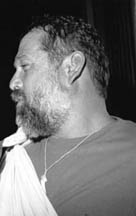 Now, we strain to see in the little light left by stars that intermittently show themselves through the storm clouds. Orion died long hours ago in the west. The three stars in the handle of the Dipper stand vertically, beckoning like a bird's wing above the northern horizon. The Southern Cross sinks into the south as we plunge through the predawn. Nainoa tells us to look for land. There! Sione, our Tongan crew member, sees what he says is land. Forty-five minutes later, the rest of us finally see something. A darker shadow solidifies on the horizon right where he has been pointing, as the sun climbs up the back of the easterly winds. Low, ringed by coral fingers that reach out miles into the surrounding ocean, Tongatapu, sacred Tonga, spouts white with blow holes carved into her flanks by the ceaseless pummeling of the sea. At first we mistake the fountains of white for whales, then we laugh with relief knowing that dry beds and hot meals await us when we land. The navigator can rest now. Like Maui with his mighty hook, he has fished the land from the sea. He has raised the island.
Now, we strain to see in the little light left by stars that intermittently show themselves through the storm clouds. Orion died long hours ago in the west. The three stars in the handle of the Dipper stand vertically, beckoning like a bird's wing above the northern horizon. The Southern Cross sinks into the south as we plunge through the predawn. Nainoa tells us to look for land. There! Sione, our Tongan crew member, sees what he says is land. Forty-five minutes later, the rest of us finally see something. A darker shadow solidifies on the horizon right where he has been pointing, as the sun climbs up the back of the easterly winds. Low, ringed by coral fingers that reach out miles into the surrounding ocean, Tongatapu, sacred Tonga, spouts white with blow holes carved into her flanks by the ceaseless pummeling of the sea. At first we mistake the fountains of white for whales, then we laugh with relief knowing that dry beds and hot meals await us when we land. The navigator can rest now. Like Maui with his mighty hook, he has fished the land from the sea. He has raised the island.
1992 Landfall Tahiti, Dennis Chun / Full Text
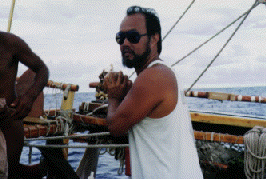 Standing at the steering paddle, I stare at the streaking reflection of the morning sun off the water. By keeping this line on specific points on the canoe, I am able to use the sun as a reference point without looking at it directly. We are expecting to sight land today and emotions are running high. Each of my crewmates anxiously stares at the horizon in hopes of being the first to sight the telltale shadow of land. Suddenly an excited yell awakens everyone on board. "There it is, over there! There's the island!" cries Nainoa. We all clamber to the port side straining to catch a glimpse. In the shadowy distance, just off the port manu, a low, dark shadow resembling a pencil mark etched where the sea and sky meet stands Mataiva. Mataiva is actually an atoll, more commonly called a "low island." Because there are no hills or mountains, the tallest visible objects are the tops of the coconut trees, which we see as we approach the island. Still six miles away, we catch a glimpse of a phenomena that I have previously only heard of. The greenish-blue color of the atoll's lagoon is reflected off the underside of passing clouds. We know that Tahiti is a day's sail almost due south of Mataiva; for most of us our journey is about to end. Suddenly the elation of making our landfall and the successful passage is replaced by a sense of loss. We have become close as a crew, as friends, and as family. Our experiences are a once in a lifetime event never to be duplicated. In the silent evening of the passage to Tahiti, we vow to carry on the traditions of the ancient Hawaiians and their long distance voyayes "for the children"- E OLA MAU KA HA HAWAI`I.
Standing at the steering paddle, I stare at the streaking reflection of the morning sun off the water. By keeping this line on specific points on the canoe, I am able to use the sun as a reference point without looking at it directly. We are expecting to sight land today and emotions are running high. Each of my crewmates anxiously stares at the horizon in hopes of being the first to sight the telltale shadow of land. Suddenly an excited yell awakens everyone on board. "There it is, over there! There's the island!" cries Nainoa. We all clamber to the port side straining to catch a glimpse. In the shadowy distance, just off the port manu, a low, dark shadow resembling a pencil mark etched where the sea and sky meet stands Mataiva. Mataiva is actually an atoll, more commonly called a "low island." Because there are no hills or mountains, the tallest visible objects are the tops of the coconut trees, which we see as we approach the island. Still six miles away, we catch a glimpse of a phenomena that I have previously only heard of. The greenish-blue color of the atoll's lagoon is reflected off the underside of passing clouds. We know that Tahiti is a day's sail almost due south of Mataiva; for most of us our journey is about to end. Suddenly the elation of making our landfall and the successful passage is replaced by a sense of loss. We have become close as a crew, as friends, and as family. Our experiences are a once in a lifetime event never to be duplicated. In the silent evening of the passage to Tahiti, we vow to carry on the traditions of the ancient Hawaiians and their long distance voyayes "for the children"- E OLA MAU KA HA HAWAI`I.
1992 Homecoming Hawai’i, Wallace Wong / Full Text
Dec. 06--It's hard to imagine that I sailed all that way. It seems like yesterday that we left Tahiti and those storms and hot days that we endured is now just a memory. I enjoyed this experience on the ocean, sailing the Hokule'a with a sky filled with stars. I will never forget it and look forward to the next voyage. I am happy to be home and glad that the Hokule'a is safe and at home. I will miss those twelve courageous crew-members that I spent over a month with. From Rarotonga to Tahiti to Honaunau, Moloka'i and on to Kualoa, I got to know and respect each and everyone of them and I'll never forget them. Since the beginning of Hokule'a in 1976 I've always wanted to be a part of it and I finally was able to experience the feeling of what our ancestors experienced. The adventure and agony of sailing as well as the happiness of sighting Hawai'i after such a long voyage from the South Pacific. The camaraderie of the crew, your friends; your family at sea; people you look to for strength and courage and help when in need.
1999 Moana Doi, Crewmember since 1990. Voyage from the Marquesas to Managareva 1999.
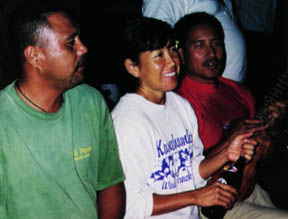 I've always loved the ocean. Ever since high school I paddled for Lanikai Canoe Club, and later for Kailua Canoe Club. In December of 1989, Paige Barber (my hula sister), invited me to the Polynesian Voyaging Society's annual meeting. There I met Nainoa Thompson, and a few months later he called and asked if I would like to begin crew training. I had no prior experience as far as sailing, but was willing and ready to learn. Excited and eager, we began crew training for the 1992 voyage to Rarotonga, Cook Islands. Since my first experience on board Hokule'a, I have not been able to walk away. Hokule'a has taken me to places that I probably would only dream of going to. The places I've been, the people I've met, the wonderful experiences, I will never forget. I am truly grateful and I feel it is such a privilege and an honor to be one of the few to sail on Hokule'a. To me, voyaging is not just about sailing, it's about life and it's a journey in which you look within yourself. Life is all about taking risks, enjoying , doing what makes you happy, and looking beyond the horizon! AITA PE'A PE'A!!
I've always loved the ocean. Ever since high school I paddled for Lanikai Canoe Club, and later for Kailua Canoe Club. In December of 1989, Paige Barber (my hula sister), invited me to the Polynesian Voyaging Society's annual meeting. There I met Nainoa Thompson, and a few months later he called and asked if I would like to begin crew training. I had no prior experience as far as sailing, but was willing and ready to learn. Excited and eager, we began crew training for the 1992 voyage to Rarotonga, Cook Islands. Since my first experience on board Hokule'a, I have not been able to walk away. Hokule'a has taken me to places that I probably would only dream of going to. The places I've been, the people I've met, the wonderful experiences, I will never forget. I am truly grateful and I feel it is such a privilege and an honor to be one of the few to sail on Hokule'a. To me, voyaging is not just about sailing, it's about life and it's a journey in which you look within yourself. Life is all about taking risks, enjoying , doing what makes you happy, and looking beyond the horizon! AITA PE'A PE'A!!
1999 Navigating in the Marquesas and to Mangareva, Catherine Fuller / Full Text
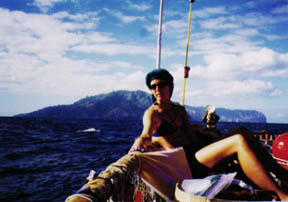 The most striking aspect of our trip through the [Marquesas] islands, besides the geography, was the aloha and the generosity of the people. We were fed like royalty at each stop; a combined effort of each village to feed 23 people. We ate crab, chicken, pork, beef, fish of all kinds, taro, ulu, fresh fruit and po'e. And of course, the ever present pamplemousse, or grapefruit. Without knowing us, these people opened their homes and their hearts. We've never eaten so well on a voyage before, It's almost embarrassing to think of the comfort most of us are accustomed to at home, as compared to the simplicity we find here. … They have beautiful islands where they can be self-sustaining. They have fish, fresh water, pigs, chickens, ulu and taro, and no need for TV or radio. On the canoe, because space is so limited, simplicity is key. Personal gear is limited to (what will fit in) a 48-quart cooler….Trying to live a simpler life opens your mind; for me, I can allow myself to enjoy the voyage and to discover my own strengths and weaknesses. I see how much clutter I live with at home, the clutter of material possessions and mental distractions. Voyaging on Hokule'a is a privilege, and I am honored to be here. The simplicity of living on the canoe is a luxury that is priceless.
The most striking aspect of our trip through the [Marquesas] islands, besides the geography, was the aloha and the generosity of the people. We were fed like royalty at each stop; a combined effort of each village to feed 23 people. We ate crab, chicken, pork, beef, fish of all kinds, taro, ulu, fresh fruit and po'e. And of course, the ever present pamplemousse, or grapefruit. Without knowing us, these people opened their homes and their hearts. We've never eaten so well on a voyage before, It's almost embarrassing to think of the comfort most of us are accustomed to at home, as compared to the simplicity we find here. … They have beautiful islands where they can be self-sustaining. They have fish, fresh water, pigs, chickens, ulu and taro, and no need for TV or radio. On the canoe, because space is so limited, simplicity is key. Personal gear is limited to (what will fit in) a 48-quart cooler….Trying to live a simpler life opens your mind; for me, I can allow myself to enjoy the voyage and to discover my own strengths and weaknesses. I see how much clutter I live with at home, the clutter of material possessions and mental distractions. Voyaging on Hokule'a is a privilege, and I am honored to be here. The simplicity of living on the canoe is a luxury that is priceless.
1999 Sailing to Rapanui, Chad Baybayan / Full Text
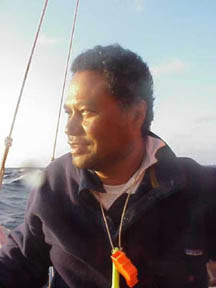 October 4: The night sky on the ocean can be mesmerizing. Stars cascade overhead showering the canoe and ocean below it with light from the heavens. The moon rises slowly out of the sea, making a trail of golden light beneath it. Wavelets lap against the hull of the canoe like little hands that reach up and touch Hokule'a, gently pushing us along the way. We move to a gentler and softer pace, influenced by the rhythm and pulse of the sky and sea that surrounds us. As the planet slowly turns and the sun begins to flood the morning sky with brilliant streaks of oranges and reds, another night has ended and another day begins, the cycle of this voyage once again renewing itself.
October 4: The night sky on the ocean can be mesmerizing. Stars cascade overhead showering the canoe and ocean below it with light from the heavens. The moon rises slowly out of the sea, making a trail of golden light beneath it. Wavelets lap against the hull of the canoe like little hands that reach up and touch Hokule'a, gently pushing us along the way. We move to a gentler and softer pace, influenced by the rhythm and pulse of the sky and sea that surrounds us. As the planet slowly turns and the sun begins to flood the morning sky with brilliant streaks of oranges and reds, another night has ended and another day begins, the cycle of this voyage once again renewing itself.
Hokule'a, now in the heart of the tradewind belt, pushes slowly eastward under the soft undersides of the fair weather cumulus clouds that float above us. The conversation of the day centers around how the many male members of this crew met their spouses. One crew member remembered starting a new job and walking into her office on the first day of work without knocking. She looked at him, shouting "Excuse me, were you raised in a barn? Don't you knock before entering?" It was love at first sight. We married two years later.
The canoe is filled with this type of light humor, the mood matching the pleasant weather of the day. In the quiet breaks that fill my day, my mind drifts off, contemplating and remembering the many evolutions that both Hokule'a and I have experienced in the 24 years that we've shared. Time and the powerful experience of voyaging have bonded me in a strong set of beliefs that orient the internal compass that navigates my life. Twenty-four years ago the job that I do now was called navigating. Today, recognizing the broad roles that navigators must play and the leadership skills that they need to possess, we redefined the term navigation, calling it now the art of wayfinding. Wayfinding is more than guiding the canoe. It is about nurturing a crew of friends by building positive relationships on the deck of this canoe and among the communities we visit. It is also about continuing the tradition of honoring our ancestors, and the culture and heritage they represent. Lastly, it is about cherishing the spirit of the many friends and supporters that fill Hokule'a's sails through their effort and work.
In 1995, when Bruce Blankenfeld and I sailed Hawai'iloa, the newest of the Hawaiian voyaging canoes, to Tahiti on her maiden voyage, we set a very simple goal for our crew. We would work to be better friends when we arrived than we began. As navigators and as a crew we would "raise" the islands we were seeking if we all did our jobs. But how we felt as a crew about the totality of the experience was as important a goal as making that landfall. On this voyage it is that very spirit that we embrace, one of caring, making new discoveries and building new and deeper friendships along the way. So our voyage continues at a much slower pace, but with that strong feeling very much intact.
1999 Landfall Rapanui, Three Navigators
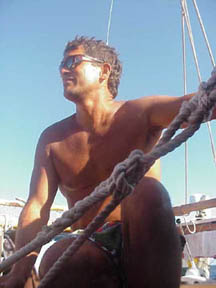 Bruce Blankenfeld: A lot of things have happened on this voyage that gave me chicken skin. The port hull of the canoe is the wahine hull and the starboard hull is the Kane hull. The symbolism is that the male and the female forces give us life. The symbolism is that they also balance each other - they help each other survive in the ocean. The mana in this canoe comes from all the people in the past who have sailed aboard Hokule'a and cared for her. I think of the literally thousands of people who have come down and given to the canoe when she was in dry dock. I think of Bruno Schmidt in Mangareva who showed up with his truck every morning to take us wherever we needed to go. I think of the people in Tautira and Aotearoa and the Marquesas who did the same. The list is endless. All of this malama - this caring - adds to the mana of the canoe. It is intangible but it is alive and well. We can all feel it. I just want to acknowledge it. In this crew we have shown a nice respectful balance. We have shown that we all know how to work hard and how to treat each other well and that was one of the most memorable parts of the voyage for me. The work ethic among this crew was fabulous. There was not one negative word. This kind of caring for each other is part of the on-going rediscovery of what voyaging is all about.
Bruce Blankenfeld: A lot of things have happened on this voyage that gave me chicken skin. The port hull of the canoe is the wahine hull and the starboard hull is the Kane hull. The symbolism is that the male and the female forces give us life. The symbolism is that they also balance each other - they help each other survive in the ocean. The mana in this canoe comes from all the people in the past who have sailed aboard Hokule'a and cared for her. I think of the literally thousands of people who have come down and given to the canoe when she was in dry dock. I think of Bruno Schmidt in Mangareva who showed up with his truck every morning to take us wherever we needed to go. I think of the people in Tautira and Aotearoa and the Marquesas who did the same. The list is endless. All of this malama - this caring - adds to the mana of the canoe. It is intangible but it is alive and well. We can all feel it. I just want to acknowledge it. In this crew we have shown a nice respectful balance. We have shown that we all know how to work hard and how to treat each other well and that was one of the most memorable parts of the voyage for me. The work ethic among this crew was fabulous. There was not one negative word. This kind of caring for each other is part of the on-going rediscovery of what voyaging is all about.
Nainoa Thompson : The voyage is pau and this gives me almost an empty feeling. But everyone should be proud of this accomplishment. We have traveled to the last corner of the Polynesian triangle and that achievement is not just ours - it belongs to everyone who has donated a portion of the millions of man hours spent taking care of the canoe over the almost 25 years since her creation. We worked hard to prepare for this voyage but it was not just academic preparation and physical training that got us here. It was my plan to continue sailing southeast and tack back northeast at sunset - but the wind shifted northeast and if we tacked we would have been going back the way we had come. So instead I decided to follow the wind around and in the morning the island was off our port bow. The wind brought the canoe here. It's about mana. Hokule'a has latent, quiet, sleeping mana when she is tied up at the pier in Honolulu. But when the canoe is sailed by people with deep values and serious intent the mana comes alive - she takes us to our destination. The mana is inside all of us. It's tied to our ancestry and our heritage. Sometime, in the press of daily life, we neglect it. But when we come aboard this canoe and commit our spirits and souls and lives to a voyage like this one, I think we all feel it. I know I do. This is a very privileged moment for all of us - we have stepped inside that realization of mana on this voyage. When we go back to our special island home, we need to remember this moment. Mana comes from caring and commitment and values. We malama our canoe and she takes care of us. When we return to Hawaii we need to remember to malama our islands just as we do this canoe. We need to commit ourselves to the values that give life meaning. This canoe is so special - and our island home is also very special - if we learn to care for our land and our ocean they will also take care of us.
Chad Baybayan: What made this voyage so special for me was that I felt so comfortable because I knew I was among people who had earned their spot on the crew. You guys are my heroes because you all showed such a dedicated professionalism. I am proud to have sailed with you. Now we have another special journey ahead of us - to return the canoe home to our own special part of the Polynesian triangle and by doing that we honor not only our ancestors but all those people at home who have supported us at home.
1999 Life at Sea: Sailing To Tahiti from Rapanui, Kimo Lyman
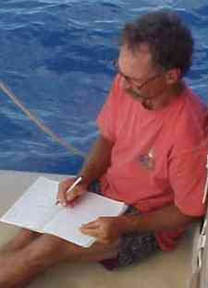 Life at sea teaches one many values that can easily be a metaphor for life ashore. Caring for one's resources, because that's all you have got, respect for the environment and eachother, how to maintain and protect your "little island" are a few that come to mind. Hardship is offset with fellowship. Together we work to raise and lower the sail, steer and trim, clean and care for the canoe and in doing so we experience harmony and strive for balance. Simple things have great value, sunrises and sunsets, a delicious meal, a fresh breeze, shade in the midday, a rain squall rinse. Courtesy, respect, cooperation become second nature. Pleasantries are common and magnified, faults overlooked or gently corrected. Living in close quarters with a dozen other individuals can be either, (a) trying and difficult or (b) easy and enjoyable. Why choose (a)? Life at sea teaches aloha as a lifestyle. Our hope is to bring what we learn ashore.
Life at sea teaches one many values that can easily be a metaphor for life ashore. Caring for one's resources, because that's all you have got, respect for the environment and eachother, how to maintain and protect your "little island" are a few that come to mind. Hardship is offset with fellowship. Together we work to raise and lower the sail, steer and trim, clean and care for the canoe and in doing so we experience harmony and strive for balance. Simple things have great value, sunrises and sunsets, a delicious meal, a fresh breeze, shade in the midday, a rain squall rinse. Courtesy, respect, cooperation become second nature. Pleasantries are common and magnified, faults overlooked or gently corrected. Living in close quarters with a dozen other individuals can be either, (a) trying and difficult or (b) easy and enjoyable. Why choose (a)? Life at sea teaches aloha as a lifestyle. Our hope is to bring what we learn ashore.
Conversation is large aboard. We've got recollections of voyages past and expectations of voyaging's future, wonderful history and geography lessons, astronomy discussions, environmental and world health, navigation technique, rightous gossip of antics ashore and personal "from home" stories, all liberally closed with huge helpings of laughter. And we've got an on board contest now starting it's second week, guess Lopaka Bee's middle name, one clue so far, it begins with the letter "M". Still there's plenty of quiet time to reflect on one's direction in life or marvel at the wonders of nature.
I've been going to sea since I was sixteen when my brother got me a berth on a sailboat back to San Francisco. On every voyage I've learned something new and the lessons continue. This time one word stands out, support. Without the support and love of each of our family members back home, we couldn't be here. I'd like to personally thank my wife for insisting I "go again" and my kids for putting up with my absence. And we, as a crew, thank all the people of Hawaii for their interest, love, and support as we sail our ambassador, Hokule'a, into the next century.
2007 Departing from Hawai‘i for Majuro and Satawal, on Maisu, Pomaikalani Bertelmann
 The rays of the sun stretch over the cliffs of Manuka and lights up the pathway to Kahiki. Mother and child wait in patience for the exact moment to 'oki from the last form of physical connection to the 'aina. In the brilliance of purple, blue, pink and vibrant orange, the face of ka la is seen and it is time. The call comes from the mother, "ready to go?", the response, "i'm right behind you". In minutes, Hokule'a is underway, powered by the wind she takes her time moving forward, keeping a watchful eye on Maisu. In her movement there is confidence, in the pitch and roll she is graceful, she is an example of everything that Maisu will become. Kamahele is here to watch over them.
The rays of the sun stretch over the cliffs of Manuka and lights up the pathway to Kahiki. Mother and child wait in patience for the exact moment to 'oki from the last form of physical connection to the 'aina. In the brilliance of purple, blue, pink and vibrant orange, the face of ka la is seen and it is time. The call comes from the mother, "ready to go?", the response, "i'm right behind you". In minutes, Hokule'a is underway, powered by the wind she takes her time moving forward, keeping a watchful eye on Maisu. In her movement there is confidence, in the pitch and roll she is graceful, she is an example of everything that Maisu will become. Kamahele is here to watch over them.
Blessed with love and support from famiy, friends and community, three crews will sail mile by mile to their destination. 'Alaka'i stands by as a witness, in awe, to the beauty that has just unfolded before our eyes.
In her confidence Hokule'a leads the way, pitching and rolling in over the gentle swells - moving forward in a rythm in sync with the sea. You sense Maisu's excitement as she familiarizes her "feet" to the wet of the deep blue. They are home, they are on their way...they are three vessels, this is one voyage, we are supporting and perpetuating the legacy of voyaging traditions and values, we are applying what we've been taught and we are learning what we don't - As the days roll by we will learn, share, and record all that we have experienced.
The Journey Continues with planning for the World Wide Voyage ….
Related Readings: For portraits of crew members on the 2000 voyage home to Hawai‘is see Sam Low’s “Portraits of Voyagers, 2000”: Abraham "Snake" Ah Hee , Chad Baybayan, Tava Taupu, Pomaikalani Bertelmann,Shantell Ching, Joey Mallott, Kahualaulani Mick, Kau‘i Pelekane.
